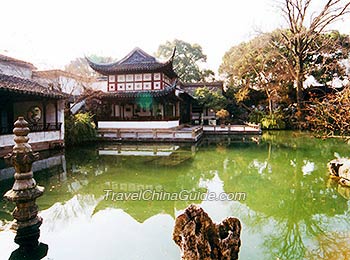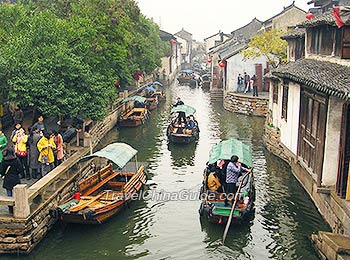Suzhou History
 |
| Classical Suzhou Garden |
The City Was Built 2,500 Years Ago
In 514 BC in Spring and Autumn Period (770 - 476 BC), Suzhou city was built by General Wu Zixu under the order of He Lu, king of Wu State, magnificent with sixteen gates on land and over water. The city was named Helu and taken as the capital of Wu State, famous for making swords. Most people think it’s the beginning of Suzhou history and the city becomes the oldest city still existing in China.
Became Regional Center since Qin and Han Dynasties (221 BC - 220 AD)
After years of wars, Emperor Qin Shi Huang unified the whole China for the first time and established the Qin Dynasty (221 - 207 BC). Suzhou was later established as Wu County, as an important part of unified China. This was a new chapter in Suzhou history. It had a rapid development in Han Dynasty (202 BC - 220 AD) and become the center of economy, politics and culture in this region.
Remarkable Development Thereafter
In the Three Kingdoms Period (220 - 280 AD), Suzhou area belonged to the Kingdom of Wu (222 - 280 AD), and the techniques of building boats and ships were further improved. In Eastern Jin Dynasty (317 - 420 AD) and Northern and Southern Dynasties (420 - 589 AD), a number of people from the north affected by wars migrated to the south, including Suzhou, bringing northern culture and technologies. Suzhou benefitted from this new influence.
In 589 AD in Sui Dynasty (581 - 618 AD), the Grand Canal was opened, and Suzhou was a vital port along it. It was also during this time period that the name Suzhou started to be used. Till the middle of Tang Dynasty (618 - 907 AD), Suzhou had been a vital economic center in the whole country benefiting from the Grand Canal.
A Good Time in Song Dynasty (960 - 1279 AD)
In the Song Dynasty, it was a boom time in Suzhou history. Suzhou had been a significant city as the center of agriculture, culture, handicraft industry and commerce at that moment. It was said the grains produced in Suzhou could satisfy the needs of all of China, and the silk in Suzhou was well-known. Suzhou, together with Hangzhou, was compared to heaven on the earth henceforth. Especially during the Northern Song Dynasty (960 - 1127 AD), it was the heyday of literature and culture in Suzhou. Initiated by the great litterateur and prime minister Fan Zhongyan, many talents were cultivated in Suzhou and became the pillars of the country.
 |
| Water Town in Suzhou |
During the Ming and Qing periods, Suzhou was prosperous with a large population and big tax handed to the court. The city was home to the largest trading market. Grains from Jiangxi and Hunan gathered here and then was transferred to Zhejiang, Fujian, etc. through the land and water transport ways. It was also one of the four largest commercial centers in China, and the cost of land was correspondingly high. It was an important cultural town as quite many cultural celebrities lived in Suzhou, and it was regarded as a must-see place for scholars and students in the field of literature. The famed classical gardens in Suzhou were mostly built in this period as well.
New Era in Modern Times
After the Qing Dynasty (1644 - 1911 AD) died out, Suzhou was still a crucial city and it survived by developing national industries of spinning, silk weaving, knitting, buttons and flour, etc. In particular, the silk made in Suzhou is famous worldwide. Nowadays, Suzhou is one of the key cities in the Yangtze River Delta, ranking 58th in the Global Top 500 Cities in 2019. 2,500-year Suzhou history has left the city a number of historical sites, which also makes it a famous tourist city.